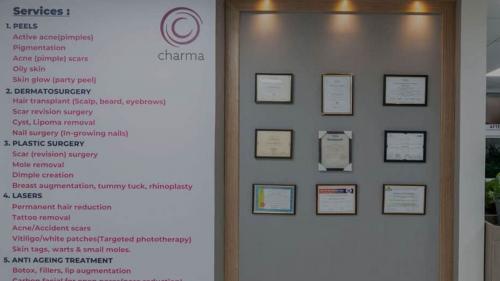What are the different types of acne and how to treat them?

Acne is not a joke. While we may find it amusing to name the massive zit on our forehead or the pimple that will undoubtedly follow an impending deadline, severe acne is not amusing. It is not as simple as simply washing your face more thoroughly to achieve clear skin. When you have severe acne, you have numerous types of breakouts in different areas that require different treatments.
Here in this article, Charma Clinic dermatologist Dr. Rajdeep Mysore, will share some details on acne and options for Acne Treatment in Bangalore. If you have acne-prone skin, here's everything you need to know about how to get rid of it.
What Are the Types of Acne?
There are two forms of acne: non-inflammatory acne and inflammatory acne. There are six different varieties of acne in these two categories: whiteheads, blackheads, papules, pustules, cysts, and nodules. Non-inflammatory acne includes whiteheads and blackheads, whereas inflammatory acne includes papules, pustules, cysts, and nodules. People frequently suffer from various forms of acne at the same time.
Let's take a deeper look at each acne subtype and the symptoms they cause:
Non-inflammatory
- Acne Whiteheads: Whiteheads, also known as closed comedones, arise when pores get blocked with dead skin cells and oil. They are closed at the skin's surface and look like tiny white bumps. Whiteheads should not be popped since they cannot be eliminated by squeezing them. Attempting to squeeze a whitehead can cause skin injury and scars.
- Blackheads: Blackheads are known as open comedones because the top of the pore remains open. Because the remainder of the pore is clogged, blackheads show little black spots on the skin's surface. Blackheads form when pores get blocked with oil and dead skin cells, just like whiteheads do. Although squeezing a blackhead can eradicate it, doctors do not advocate it since it might result in scarring.
Inflammatory Acne
Papules: Papules are little red pimples on the skin that are extremely painful to the touch. They arise when comedones become irritated and germs, oil, and dead skin cells become trapped beneath the skin's surface. Papules frequently cluster together, resulting in an appearance similar to a rash. Squeezing papules is never a good idea since it might aggravate the inflammation and create scarring.
Pustules: Pustules resemble papules in appearance, but the main distinction between the two is that pustules contain pus. This causes a bulging lump on the skin's surface that appears white or yellow. Pustules may only be drained by a dermatologist. Attempting to squeeze pustules might result in black stains on the skin and the spread of germs.
Nodules: Nodules form deep under the skin and are typically painful. They look like huge, hard pimples that are stiff to the touch. When germs enter the pores and produce an infection, nodules develop.
Cysts: Cysts are severe acne lesions that look like big, red lesions filled with pus. Cysts resemble boils in appearance and are frequently unpleasant. They appear when there is an infection deep beneath the skin and have the highest risk of permanent scarring when compared to other forms of acne.
What are the popular treatments for Acne?
1. Medicine and Topical Cream
Acne is most commonly treated medically using creams and pills containing antibiotics and retinoids, as well as oil-removing cleansers. In pregnancy, treatment must be modified.
2. Chemical Peel
Chemical peels can be used to treat a wide range of skin disorders as well as to improve the look of normal skin. Many individuals are terrified of the phrase chemical because they believe it may harm their skin. A chemical peel creates controlled harm to the skin by applying weak acids that cause peeling or exfoliation. Normal skin peels or exfoliates slowly, and the peel accelerates this natural process. It is critical to understand which peel to apply on whatever skin type to achieve good results without harming the skin.
Superficial combination peels are the most often used peels in most clinics because they provide the desired outcomes while producing little obvious skin damage. These peels also have a short recovery time. Combination peels employ a lower dosage of various acids to lessen skin damage while enhancing it more than a single-ingredient peel. Peels are performed every 2-4 weeks. Most people require six treatments to get satisfactory acne management.
Peels are also used to treat melasma, dull skin, greasy skin, open pores, uneven skin tone, scar improvement, and other skin conditions. Peels are used in different ways based on the skin type and condition being treated. The majority of acids found in peels are organic acids like glycolic acid, salicylic acid, lactic acid, phenol, trichloroacetic acid, and others.
Some peels contain vitamins or bioactive chemicals such as ferulic acid, ascorbic acid, and tranexamic acid, which allow them to penetrate deeper into the skin than creams. Charma Clinic provides the finest Acne Peel treatment in Bangalore for acne management.
Lasers and Light-Based Treatment
A hair removal laser is the most often used laser in dermatology. Three main types of light-based devices are utilized to treat acne. Lasers are mostly used to treat acne-related pigmentation. They can, however, be used to lessen the redness associated with acne. Laser Acne Treatment in Bangalore, is performed by professionals at Charma Clinic, who use world-class lasers to successfully control acne skin disorders and revitalize the skin by boosting collagen synthesis.
IPL is a light-based technology that, like a laser, lowers redness and active red pimples.
It works by specifically targeting a pigment called porphyrin, which is generated by the bacterium that infects the pimples. The light's energy is absorbed by the porphyrin pigment, which kills the bacteria. The light is also absorbed by the little blood vessels that supply the pimples, which helps to eliminate active pimples much faster. It also aids in the reduction of inflammation and consequent scarring.
Acne scars are also treated with various types of lasers. Non-ablative lasers are utilized when the patient cannot afford to take time off work or miss any days following each session. However, the best outcomes are obtained using fractional ablative lasers.
Micro-needling fractional RF, or MNRF, is a new scar therapy method that works similarly to fractional ablative lasers but with less downtime.
Acne treatment at Charma Clinic is offered at a reasonable rate by specialists who use the finest therapy and procedures to deliver dependable results.
Get a consultation with Dr. Rajdeep Mysore for more details on acne treatment today.
Advertise on APSense
This advertising space is available.
Post Your Ad Here
Post Your Ad Here



Comments